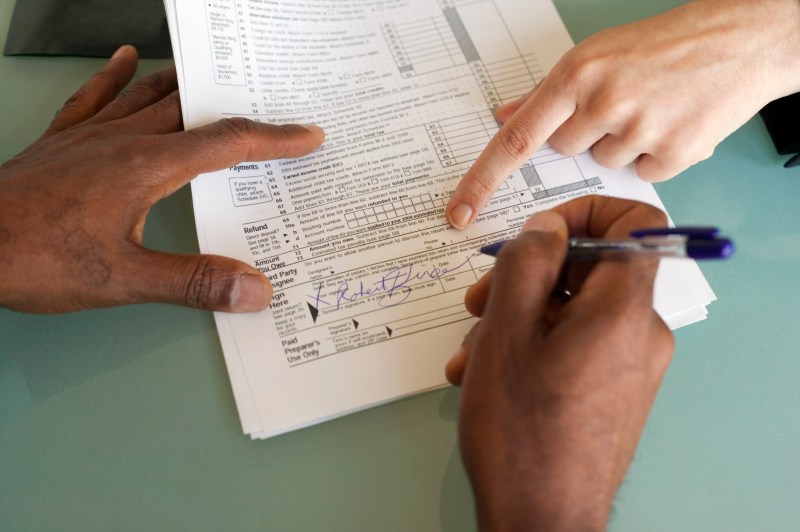How Much Federal Taxes Do I Owe – The IRS adjusts tax brackets and rates every year to account for inflation and “bracket shifts.” Batch creep occurs when a taxpayer moves into a higher income tax bracket or does not receive enough credits and deductions due to inflation. Do you know how increases in the standard deduction and tax brackets will affect you?
1. For the 2023 tax year, the standard deduction increases. See growth summary below:
How Much Federal Taxes Do I Owe
While this is good news, these updates won’t have a significant impact on your taxes, cash flow or budget. These updates are intended to prevent inflation and keep taxpayers stable.
How Much Do I Owe The Irs? Here’s How To Find Out
Simply put, an increase in the standard deduction means less household income and more tax revenue going to better tax brackets.
Starting in 2022, we hope to revise our tax templates using updated 2023 numbers to provide you with familiar and helpful tax guidance. Read on for a hypothetical example of the impact of increasing the standard deduction and tax brackets in 2023.
As you can see, they reported total income of $100,000, minus pre-tax 401(k) contributions and the standard deduction of $27,700. Because the standard deduction has increased from $25,900 to $27 in 2022. 700 In 2023, Martin and Angela’s taxable income decreases. That means they are expected to pay less in federal taxes this year.
Tax brackets calculate the tax rate you pay on each part of your income. Tax brackets are part of our progressive tax system, which means tax rates increase as someone’s income increases. There are seven federal tax brackets for 2023 (see Figure 2).
Inheritance Tax: What It Is, How It’s Calculated, And Who Pays It
As shown above, Martin and Angela’s taxable income is split to take advantage of the lowest tax rate. This means they are taxed at 10% on the first $22,000 of joint income and 12% on the remaining taxable income. In 2022, the maximum allowable income at the lowest tax rate of 10% is $20,550. The maximum income allowed in 2023 is $22,000.
If Martin and Angela fall into a higher tax bracket in the future, their taxable income will be spread across each appropriate tax bracket to take advantage of possible lower tax rates.
After doing this exercise with all taxable income, you can see that Martin and Angela’s total in 2022 is $7,881 and in 2023 it is $7,636. This means they will pay $245 less in federal taxes in 2023 than in 2022. This is a welcome update, not a life-changing one.
If you have any questions about your unique tax situation, please take the time to contact our team. As always, we want to hear from you!
Required Minimum Distributions (rmds) For Dividend Investors
Disclaimer: This article is for educational purposes only and does not predict 2022 tax positions. Fictional example of not filing a complete return. Taxes Taxes are mandatory payments or charges levied by local, state, and national governments on individuals or businesses to cover the cost of public services, goods, and activities. With one day left, the question of who pays taxes always comes up at this time of year.
A recent Pew Research Center survey found that “the sense that some wealthy people are not paying their fair share” worries 79 percent of respondents somewhat or very much. Recent analysis by the Joint Committee on Taxation suggests these respondents can rest easy.
For U.S. personal income taxes, the average tax rate is the total tax paid divided by taxable income. The marginal tax rate shows the amount of tax paid on the next dollar earned, while the average tax rate shows the total share of income paid in taxes. The incremental payment as we increase the revenue scale (see chart below). As a group, taxpayers with income over $1,000,000 pay an average tax rate of 27.4%. At the bottom of the income scale, taxpayers making less than $10,000 pay an average tax rate of -7.1%, meaning they receive money from the government in the form of refundable tax credits. Offers refundable tax credits. A federal tax refund in excess of the taxes paid during the year. In other words, a refundable tax credit may create a negative federal tax liability. An example of a refundable tax credit is the earned income tax credit. s. The next item of income has a lower negative tax rate of 11%.
These results are as expected. The U.S. income tax system uses a progressive tax system with marginal rates. The marginal tax rate is the additional tax paid on each additional dollar of income earned. The average tax rate is the taxes paid divided by total income. A 10% marginal tax rate means that 10 cents of every subsequent income is taxed. People’s incomes are increasing, and so are the number of tax credits. A tax credit is a provision that reduces a taxpayer’s final tax bill, dollar for dollar. Tax credits differ from deductions and exemptions in that tax credits do more than directly reduce a taxpayer’s taxable income. s (refundable and non-refundable) limit income tax liability.
Paying 2022 Tax Estimates
Many people believe that people pay more in federal taxes than in personal income taxes. They are correct. People also pay Social Security taxes (Social Security, Medicare, Unemployment Insurance, etc.), business taxes, and excise taxes. Special taxes are taxes levied on certain goods or activities. Excise taxes are typically levied on cigarettes, alcoholic beverages, sodas, gasoline, insurance premiums, entertainment activities, and gambling and generally constitute a relatively small and variable portion of state and local tax revenues, and to a lesser extent, federal tax revenues . remember
But even taking these taxes into account, the tax code is still progressive. A report by the Joint Committee on Taxation shows that average marginal income and Social Security taxes increase significantly as income increases. The average combined marginal tax rate for those making less than $10,000 is 7.7 percent, and the average combined marginal tax rate for those making more than $1,000,000 is 44.6 percent.
When we look at the average tax rates that combine income and payroll taxes with sales and consumption taxes, we find that progressivity is maintained (see chart below). The average tax rate for taxpayers making more than $1 million is 33.1%. For those making between $10,000 and $20,000, the average overall tax rate is 0.4%. (The average tax rate for individuals in the lowest income tax bracket, A. A tax rate is a range of income that is taxed at a certain rate, usually varying based on filing status. Progressive income for an individual or legal entity increases with increasing tax rates as income increases in the tax system. There are seven federal personal income tax brackets; the federal corporate income tax system is uniform. 10.6%, or 10,000 per bracket (up to $40,000). For income below $10,000.)
Whether this level of progressivity is appropriate is subject to a wider discussion, but it is important to note that progressive taxes A progressive tax is an average tax burden that increases with income. High-income households bear a disproportionate share of the tax burden, while low- and middle-income taxpayers bear a relatively small tax burden. It involves economic costs.
How Do Tax Brackets Actually Work?
There is evidence that progressive taxes limit economic growth. The OECD reported in 2012 that eliminating progressive taxes would improve living standards. Our economic model (TAG) suggests that higher marginal revenue would grow the economy by 0.4%, while refundable tax credits would have little impact on growth.
We need to use as much information as possible to evaluate these types of exchanges when determining what the tax system is and who should be taxed. A white circle with a black border surrounding an upward chevron. It means “Click here to return to the top of the page.”
Most or all of the offers on this site are sourced from companies that receive internal compensation (see the full list here). Advertising matters may affect how and where products appear on this site (including the order in which they appear), but they do not affect editorial decisions about which products we write about and how we review them. Personal Finance Insider considers a variety of offers when making recommendations; however, we do not guarantee that the information represents all products or offers on the market.
Personal Finance chevron This represents a section or drop-down menu, and sometimes the previous/next navigation option. tax
How Much Do I Owe The Irs? Handling Back Taxes
Facebook’s icon is the letter F. Facebook email icon envelope. This represents the ability to send email.
How much federal taxes do i owe, why do i owe federal taxes, owe federal taxes penalty, owe federal taxes, find out how much taxes you owe, federal taxes you owe, what happens if you owe federal taxes, do i owe federal taxes, i owe federal taxes, how do you owe taxes, how do i owe federal taxes, owe federal taxes payment plan








